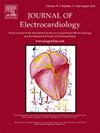A novel electrocardiogram-based model for prediction of dementia—The Atherosclerosis Risk in Communities (ARIC) study
IF 1.3
4区 医学
Q3 CARDIAC & CARDIOVASCULAR SYSTEMS
引用次数: 0
Abstract
Aim
Create an ECG-based model to predict dementia and compare its performance with the existing Cardiovascular Risk Factors, Aging, and Dementia (CAIDE) model.
Methods and Results
Participants without prevalent dementia in the Atherosclerosis Risk in Communities study were studied. Visit 4 (V4) (1996–98, mean age, 62 years) and V5 (2011–13, mean age, 75 years) were used as baselines. Incident dementia cases were adjudicated through 2019. We created parsimonious ECG models by using Cox regression with a backward selection method. C-statistic (95 % CI) of the ECG-based model (two or three ECG variables and age) was higher than the CAIDE model (seven variables) at V4 (0.72 [0.71–0.74] vs. 0.67 [0.66–0.68]) and V5 (0.70 [0.68–0.72] vs. 0.64 [0.62–0.66]). The ECG-based model was well calibrated, but the CAIDE model was poorly calibrated at V4 (P < 0.001).
Conclusion
For middle-aged and older adults, a novel ECG-based model has good discrimination that is superior to the CAIDE model in predicting dementia. Since ECG variables are readily obtainable, the ECG-based model will be easy to adopt clinically.
一种新的基于心电图的痴呆预测模型——社区动脉粥样硬化风险(ARIC)研究
建立一个基于心电图的模型来预测痴呆,并将其与现有的心血管危险因素、衰老和痴呆(CAIDE)模型进行比较。方法和结果对社区动脉粥样硬化风险研究中无流行痴呆的参与者进行研究。随访4 (V4)(1996-98年,平均年龄62岁)和随访5(2011-13年,平均年龄75岁)作为基线。到2019年为止,对偶发性痴呆案件进行了判决。采用Cox回归和逆向选择方法建立了简洁的心电模型。基于ECG的模型(2个或3个ECG变量和年龄)的c -统计量(95% CI)在V4(0.72[0.71-0.74]比0.67[0.66-0.68])和V5(0.70[0.68-0.72]比0.64[0.62-0.66])高于CAIDE模型(7个变量)。基于心电图的模型校准良好,但CAIDE模型在V4时校准较差(P <;0.001)。结论对于中老年人,基于脑电图的新模型在预测痴呆方面具有较好的辨别力,优于CAIDE模型。由于心电图变量容易获得,因此基于心电图的模型易于临床应用。
本文章由计算机程序翻译,如有差异,请以英文原文为准。
求助全文
约1分钟内获得全文
求助全文
来源期刊

Journal of electrocardiology
医学-心血管系统
CiteScore
2.70
自引率
7.70%
发文量
152
审稿时长
38 days
期刊介绍:
The Journal of Electrocardiology is devoted exclusively to clinical and experimental studies of the electrical activities of the heart. It seeks to contribute significantly to the accuracy of diagnosis and prognosis and the effective treatment, prevention, or delay of heart disease. Editorial contents include electrocardiography, vectorcardiography, arrhythmias, membrane action potential, cardiac pacing, monitoring defibrillation, instrumentation, drug effects, and computer applications.
 求助内容:
求助内容: 应助结果提醒方式:
应助结果提醒方式:


